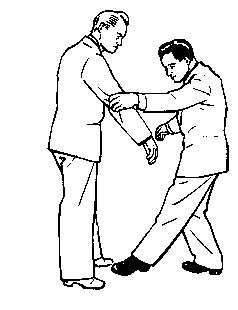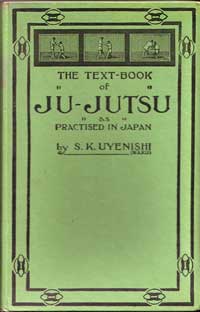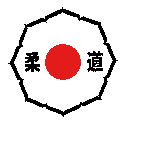by Raku Uyenishi“The Textbook of Ju-Jutsu as Practised in Japan” (1905) The human body is (or should be) carried erect on two legs. The reason is simply because, in the first place, it is better balanced, and secondly, because the balance is more easily maintained in the erect position. The human body is (or should be) carried erect on two legs. The reason is simply because, in the first place, it is better balanced, and secondly, because the balance is more easily maintained in the erect position.
Walking consists of leaning forward or losing the balance in a forward direction, when a leg is brought forward to catch the balance again. In walking backwards we have the same process reversed. It is the quick and agile man who will have the ability to regain balance more easily after having once lost it, and not the strong man, for strength pure and simple can in no way be brought forward as a factor in balance. Knowledge of balance, and how to disturb it is the “mystery” which enables the Ju-Jutsu man so easily to throw stronger and heavier opponents without any great effort and without using strength (in the common acceptance of the term). For example, if you are weighing (even tons) material on a scale or balance a single ounce, or the slightest touch of even a single finger will move the beam down at a certain point of balance. In the same way, if the human body is at a certain point of balance, the least little pull or push will disturb that balance, and a fall becomes inevitable unless support is adjusted at or before the critical moment. There must of course be a moment after which it becomes physically impossible to readjust the lost balance, or in other words to “save the fall.” It will be evident to the sceptic that no amount of strength exerted after that point has been reached will be of the least avail. So that it is, after all, only a matter of common-sense to say that on a point of actual balance, strong and weak are on par. This will become most apparent to the novice when he is first successful in making, say, a clean ankle throw. For the moment he will scarcely realise that he has, made the throw, and will feel rather that his adversary fell on purpose, but after a few more successes he will understand that the correct physical or psychological moment has been utilised. The amount of exertion which he has actually used has been so trifling that it could scarcely be definable as “strength” as strength is generally understood. However, the student must not misunderstand and think that he need put little if any force into his “pulls”. These must be definite and sharp and executed at the precise psychological moment. Balance is the whole secret of Ju-Jutsu both for attack and defence, and cannot be too assiduously practised. The student must continually bear it in mind, as a momentary omission will place him immediately at the mercy of any opponent who has any practical knowledge of Ju-Jutsu. The next thing to remember is that all movements should be performed in the most natural, easy manner possible, at an expenditure of the least possible amount of exertion. There should be no stiffness or prolonged muscle tension whatever, either in legs, arms or body. The hips should be perfectly loose, or perhaps it should be more correct to say that the trunk itself should be held quite loosely. Too much stress cannot be laid on this point since it is perhaps the most important of all, certainly quite as important as the maintenance of perfect balance. The whole body should be perfectly supple, so that when any movement is necessary, it may be made with the least possible preliminary fatigue or delay. For it takes time to relax and contract muscles. With some people this takes longer than with others, so that if both movements have to be made, valuable time will be lost. For instance, suppose you wish to throw your opponent with, say, the ankle throw to the right. In order to do so you must pull with your right hand. This should be done with a sudden sharp jerk and not with a long, strong, slow pull. It will be well to explain the reason for this now, so that the student may appreciate the advantage of keeping such a very small detail in his mind. In the first place, a sudden sharp jerk requires less expenditure of energy, and the muscles do not get tired so quickly as they would if a prolonged strain were put on them, while secondly, the sudden pull does not disturb your own balance as much as the long pull would, which is a most important point. For example when you wish to pull something or someone towards you, you naturally hang back and so lose your balance in a backward direction just sufficiently (if you can gauge at correctly) to compensate the pull. So that on the completion of the pull you will have regained your balance. Now the nearer you can keep your body to the actual balancing point, or “correct” balance, the more difficult it will be to throw you, or in the case of an attempted throw, the greater chance will you have to recover and so save yourself from disaster. You will therefore understand that the method, otherwise effective, which will entail the least deviation from this balancing point as not only the safest, but also the best. I will explain why your whole body should not be kept rigid, but, on the contrary, as free from strain as possible. If rigid, you are more easily thrown, particularly if you are a victim of pernicious systems of physical culture which cause abnormal development, bordering on the condition known as “muscle-bound.” This generally makes them stiff as well as sick and cumbrous in movement, and consequently longer in making the effort to regain the lost balance a greater amount of leverage is obtained by keeping your body supple and loose, and last by no means least, it hurts far more to fall stiffly than easily. One of the principal mistakes which the novice makes during his first few lessons is the perhaps not altogether unnatural trick he has of keeping the arms straight out in front when holding his opponent, in an attempt to “keep him off.” Since this leads to resistance and consequently flexed muscles, it is a serious fault and one what might even prove a dangerous one in serious combat, as the arms are far move likely to be broken or dislocated when straightened than when they are bent. Both arms should be limp, and the grip on your opponent’s coat a loose one, so that it may be instantly tightened for a throw or as quickly released when circumstances require it.  Don’t resist when your opponent pushes you; rather, increase your pace in that direction and pull him a little at the same time, or vice versa should he pull you. Don’t let him ever get the “strain” on you, but go with him, if anything a little faster that his pull would cause you to. By following this precept you are almost catching your balance before he makes you lose it, while he is practically losing his and is without the aid of your resistance on which he has been, more or less depending to help him regain his balance. Thus, in an easy and simple manner, you neutralise his efforts to get you off your balance and at the same time create a favorable opportunity of effecting a throw, by keeping him off his. Don’t resist when your opponent pushes you; rather, increase your pace in that direction and pull him a little at the same time, or vice versa should he pull you. Don’t let him ever get the “strain” on you, but go with him, if anything a little faster that his pull would cause you to. By following this precept you are almost catching your balance before he makes you lose it, while he is practically losing his and is without the aid of your resistance on which he has been, more or less depending to help him regain his balance. Thus, in an easy and simple manner, you neutralise his efforts to get you off your balance and at the same time create a favorable opportunity of effecting a throw, by keeping him off his.
I have found it a comparatively easy matter, even when wrestling with men who have won their laurels at European styles of wrestling, to throw them off their feet by a simple pull on the collar and sleeve when they are standing in the ordinary bent body or leaning forward position usually adopted by catch-as-catch-can or Greco-Roman wrestlers. They press forward to such an extent that their bodies assume a position in which, if they were not supported by me, they would fall down without any assistance, so that under such circumstances it should not be difficult to understand that a little tug in the direction in which they are pushing is quite sufficient to cause a fall. At the same time they lay themselves open to many other throws, particularly the one known as the stomach throw, a picturesque and singularly effective throw, and one which even a slender girl can use against the burliest opponent if she has once properly learnt it. 
While the old form, jujutsu, was studied solely for fighting purposes, Kano’s new system is found to promote the mental as well as the physical faculties. While the old schools taught nothing but practice, the modern Judo gives the theoretical explanation of the doctrine, at the same time giving the practical a no less important place.
…..T. Shidachi, 1892 |